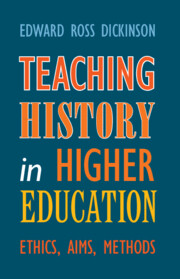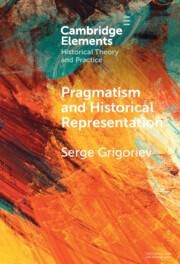1298 results
2 - Automation, Surveillance, and the Administrative State
- from Part I - Automation and the Administrative State
-
- Book:
- Combatting the Code
- Published online:
- 26 March 2025
- Print publication:
- 03 April 2025, pp 19-34
-
- Chapter
- Export citation
1 - Introduction
-
- Book:
- Nostalgia in Late Pahlavi Iran
- Published online:
- 20 March 2025
- Print publication:
- 03 April 2025, pp 1-34
-
- Chapter
- Export citation
1 - The Challenge Ahead
-
- Book:
- A Climate of Truth
- Published online:
- 27 March 2025
- Print publication:
- 27 March 2025, pp 14-20
-
- Chapter
- Export citation
When National Narratives Clash in Multinational University Classrooms: A Pedagogical Perspective
-
- Journal:
- Asia-Pacific Journal / Volume 19 / Issue 5 / March 2021
- Published online by Cambridge University Press:
- 14 March 2025, e13
-
- Article
- Export citation
Between a Forgotten Colony and an Abandoned Prefecture: Okinawa's Experience of Becoming Japanese in the Meiji and Taishō Eras
-
- Journal:
- Asia-Pacific Journal / Volume 18 / Issue 20 / October 2020
- Published online by Cambridge University Press:
- 14 March 2025, e4
-
- Article
- Export citation
The History Problem: The Politics of War Commemoration in East Asia
-
- Journal:
- Asia-Pacific Journal / Volume 15 / Issue 15 / August 2017
- Published online by Cambridge University Press:
- 14 March 2025, e3
-
- Article
- Export citation
If You Liberated Us, Why Are You Still Here? Dilemmas of Global U.S. Military Basing
-
- Journal:
- Asia-Pacific Journal / Volume 22 / Issue 5 / May 2024
- Published online by Cambridge University Press:
- 14 March 2025, e1
-
- Article
-
- You have access
- Export citation

Pacifism and Non-Violence in Contemporary Islamic Philosophy
- Mapping the Paths of Peace
-
- Published online:
- 13 March 2025
- Print publication:
- 20 March 2025
-
- Book
-
- You have access
- Open access
- Export citation
Health Care Financing Instruments during the Colonial Period in Senegal: The Historical and Institutional Nature of Policy Instruments
-
- Journal:
- Journal of Policy History / Volume 37 / Issue 2 / April 2025
- Published online by Cambridge University Press:
- 10 March 2025, pp. 160-177
-
- Article
-
- You have access
- HTML
- Export citation
1 - Introduction
-
- Book:
- The EU Law on Crypto-Assets
- Published online:
- 28 February 2025
- Print publication:
- 06 March 2025, pp 1-16
-
- Chapter
- Export citation
1 - Introduction
-
- Book:
- Luke's Unique Parables
- Published online:
- 28 February 2025
- Print publication:
- 06 March 2025, pp 1-16
-
- Chapter
- Export citation
Introduction
-
- Book:
- Teaching History in Higher Education
- Published online:
- 07 February 2025
- Print publication:
- 20 February 2025, pp 1-23
-
- Chapter
- Export citation
1 - Introduction
-
- Book:
- Making India Work
- Published online:
- 13 February 2025
- Print publication:
- 13 February 2025, pp 1-19
-
- Chapter
- Export citation
3 - The Rise and Fall of the United Kingdom’s Forgotten Utility Model
- from Part I - Utility Model Laws and Practices around the World
-
-
- Book:
- Sub-patent Innovation Rights
- Published online:
- 06 February 2025
- Print publication:
- 13 February 2025, pp 31-85
-
- Chapter
-
- You have access
- Open access
- HTML
- Export citation
2 - Origins, Expansion, and Reform
-
- Book:
- Making India Work
- Published online:
- 13 February 2025
- Print publication:
- 13 February 2025, pp 20-42
-
- Chapter
- Export citation
Conclusion
-
- Book:
- American Grasslands
- Published online:
- 06 February 2025
- Print publication:
- 13 February 2025, pp 186-196
-
- Chapter
- Export citation
Sang C. Park February 14, 1939–April 19, 2024
-
- Journal:
- Cardiology in the Young , First View
- Published online by Cambridge University Press:
- 12 February 2025, pp. 1-2
-
- Article
-
- You have access
- HTML
- Export citation

Teaching History in Higher Education
- Ethics, Aims, Methods
-
- Published online:
- 07 February 2025
- Print publication:
- 20 February 2025

Pragmatism and Historical Representation
-
- Published online:
- 06 February 2025
- Print publication:
- 06 February 2025
-
- Element
- Export citation
5 - The Vista
-
- Book:
- Tehran's Borderlines
- Published online:
- 30 January 2025
- Print publication:
- 06 February 2025, pp 76-92
-
- Chapter
- Export citation


